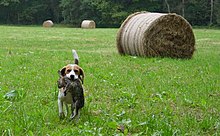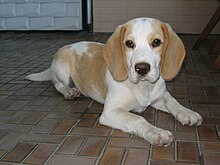Beagle (breed of dog)
| beagle | ||
|---|---|---|
|
|
||
| FCI Standard No. 161 | ||
|
||
| Origin : | ||
| Withers height: |
33-40 cm |
|
| List of domestic dogs | ||
The Beagle is a British breed of dog recognized by the FCI ( FCI Group 6, Section 1.3, Standard No. 161 ).
Origin and history
The origin of the word beagle is not clearly understood. It is possible that the word was derived from the French term begueule , which means something like open throat or loud mouth . The French term beugler would also be possible, which means to roar , or an allegedly old German term begele , which is supposed to mean scolding or scolding . The old English, French or Welsh name beag , which means as much as small , would also be possible .
The Beagle is a hunting dog that was originally bred in England as a happy pack dog especially for independent driven hunt for brown hares and wild rabbits . In the AKC and KC he is counted to the Hound group . Beagles hunt mainly in packs and are led both on foot and on horseback, in contrast to the foxhounds , who are mostly accompanied on horseback on the fox hunt. Therefore, the beagles were also known as the “poor people's cattle dogs”.
The origin of this dog breed is partly suspected in France in the area of Normandy . From there, white Hubertus dogs (also known as Chien St. Hubert ) are said to have come to England in 1066 by the Norman Talbot family in the army of William the Conqueror , whose origin was bred by monks from the monastery named after St. Hubertus until the 9th century in the Ardennes . These white hunting dogs were also called Talbots and then 600 years later in the English-speaking world also Northern Hounds or Norman Hounds . The Northern Hounds were described as a slender breed of dog that was quick and confident on the trail, but made a high-pitched, flat, and uncomfortable trail noise .
Around 1400, during the Hundred Years War in the south of France in Gascony , the British found other dog breeds that were previously unknown to them. They were impressed by the medium-sized, brightly colored and speckled dogs and their hunting qualities. But they were also described as slow and heavy, with a lot of skin substance. These dogs were later called the Southern Hounds . Unlike the Northern Hounds , the Southern Hounds were covered with black and brown spots and plates on a white background.
By to extinction powered hunting on big game such as deer and bulit big game as the Bears remained only those afraid of wild species left who hid during the day and you just by following their trail to hunt. The Northern Hounds were no longer fine-nosed enough for that. It can therefore be assumed that the origin of today's dog breeds goes back to both the Northern Hounds and the Southern Hounds . Primarily, it was in the breeding of the Hounds to the utility and not a question of appearance.
In 1515 appeared in the budget books of King Henry VIII . bookings to the Keper of the Begles for the first time . In 1615, L. R. Jackson mentioned, aka Gervase Markham to his general description of all major hunting breeds little Beagle (small Beagle), which in the saddlebag of the hunter only tire takes place and a wild track pursued, the wild but rarely themselves kill but could.
At that time, the term beagling was coined as a form of dog hunting in a pack. The Beagle was recognized as a breed by the British Kennel Club in 1890 .
description
According to the FCI's description , the beagle is a hunting dog that gives a robust and compact impression without appearing rough. Beagles measure between 33 and 40 cm at the withers . With the short, close-fitting and weatherproof fur, all known hound colors except "liver" are permitted. The main color variations that occur are: two-tone brown / white ("tan and white"), red-white ("red and white"), lemon yellow-white ("lemon and white") or three-colored black / brown / white ("tricolored") ); a broken edge is also referred to as "tricolored broken". There are also three different "pied" variants.
The head is of moderate length, powerful without being coarse, with a pronounced stop . The short legs are very strong and muscular, but not fat. The eyes are dark or hazel brown, quite large with a gentle, engaging expression. The teeth have strong jaws with full scissor bite. The low set ears are long and rounded at the end; when placed forward, they reach almost to the tip of the nose. The leather of the ears is thin and lies against the cheek. The tail is thick, set high and carried happily above the topline, but not rolled over the back or leaning forward from the base. The tip of the rod is white.
Essence
The Beagle is a happy and active dog. His nature is amiable and alert, with no signs of aggressiveness or fearfulness; in the hunt he shows tenacity and determination.
Beagles are pack dogs, they need the company of other dogs or familiar people. Up until the 20th century they were mainly bred for hunting in packs and therefore need a lot of exercise and exercise. Beagles, as pack dogs, tend to overeat.
use
Hunting use

The Beagle is rarely hunted in Germany. Nevertheless, the Beagle is excellently suited for rummaging due to its track or ferry sound and its will to find it. The original brackier hunt is practiced only very rarely in Germany due to the legal regulations on the minimum required area size of 1000 hectares . One approach led to the hunting Beagle pursuing the hare track loudly with strong persistence. Once the hunt has started, it is almost impossible to retrieve the dog. The pronounced hunting instinct leaves only two options for ending the hunt: by preying or due to exhaustion.
His strong will to find the piece makes him a bit impetuous on the trail of sweat . But with regular training, he persists even on the 40-hour-old sweat trail.
The beagle is a popular pack dog for drag hunts in Germany.
The beagle is not a retriever dog. A fully grown rabbit is too heavy for him. But his urge for activity, especially for his nose, makes him particularly suitable for work on the train. For this he carries a rabbit to the hunter over long distances. The dog likes water and can also be introduced to game birds. The Beagle is definitely a candidate for the hunting test and the sweat test.
Pack dogs
In Germany there are five packs of beagles who are trained for drag hunting (as of 2018). The train is laid with an artificial bait. The dogs set the pace, they are followed by riders, which places high demands on rider and horse due to the uneven terrain and the high speed. At the end of the hunt, the dogs receive cattle tripe, the so-called curée, as a reward for their work.
Keeping as a family dog
For centuries, this breed of dog was only bred to hunt in packs. Every Beagle who did not pursue the search for clues and the driven hunt optimally, but also those who showed aggression within the pack, was sorted out. The Beagle was originally a functional dog and was not bred as a family dog until the 20th century.
Other use
The beagle is the most common breed of dog used in scientific research. Animals are bred commercially for this purpose. Beagles are also often used as experimental animals in biomedical research on dogs .
Since 1984 the so-called Beagle Brigades have been used by the Customs and Border Protection Authority ( USCBP ) to search for illegally imported food, plant and animal parts, especially at border crossings, ports and airports. In 2001, 60 Beagle units were active at 21 international airports in the USA.
Special diseases
Beagles are predisposed to hound ataxia , meningitis arteritis , obesity and Lafora's disease . Lafora disease is an autosomal recessive inherited gene defect that prevents glucose from being converted into glycogen. This disease has been detected in beagles by a genetic test since 2017. In the Beagle Club Germany e. V. has been compulsory for this test for all breeding dogs since 2018, so that further spread of this disease, which also occurs in humans and other dog breeds, is prevented.
Remarks
- ↑ s. en: Talbot (dog)
- ↑ s. en: Beagling
Sources and further links
Individual evidence
- ↑ Overview of coat colors
- ↑ http://www.drfv-jagdreiten.de/hunde.html
- ^ Hunting tests in the Jagd-Beagle eV association ( Memento from February 2, 2009 in the Internet Archive )
- ↑ Beagle Meute Münsterland
- ^ Ophelia Nick: Placement of laboratory dogs in private hands. (Dissertation). Munich 2012, p. 2. ( pdf online 3.7 MB )
- ↑ United States Customs and Border Protection: [1] (Eng.)
- ↑ United States Department of Agriculture - Animal and Plant Health Inspection Service - Plant Protection and Quarantine - National Detector Dog Manual: [2] (Engl.)
- ↑ U.S. Beagle Brigade is First Defense Against Alien Species , National Geographic , June 7, 2001
literature
- Jochen H. Eberhardt: The Beagle: Practical advice for keeping, care and upbringing . Parey Buchverlag, Berlin 1997, ISBN 3-8263-8426-1 .
- Jochen H. Eberhardt: Beagle: The breed portrait . Kynos-Verlag , Mürlenbach 1996, ISBN 3-924008-41-8 .
- Andrew H. Brace: Beagle today . Kynos-Verlag, Mürlenbach 1999, ISBN 3-933228-10-7 .
- Bärbel Kronz: Guide for a happy Beagle life . Cadmos, Brunsbek 2004, ISBN 3-86127-777-8 .
- Jürgen Herbst, Hans Stark: The Beagle . Neumann-Neudamm, Melsungen 2007, ISBN 3-7888-1137-4 .
- Dan Rice: The Beagle Handbook . Hauppauge, New York 2000, ISBN 0-7641-1464-6 . (English)




